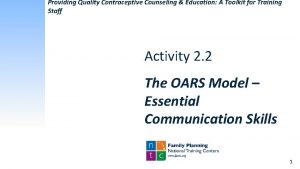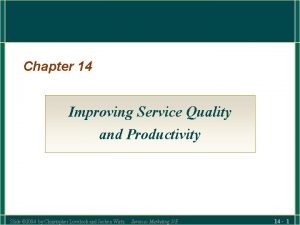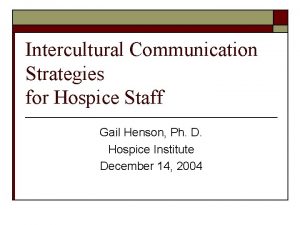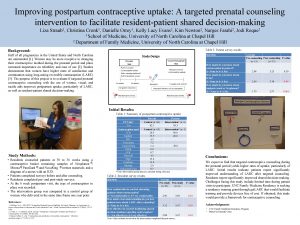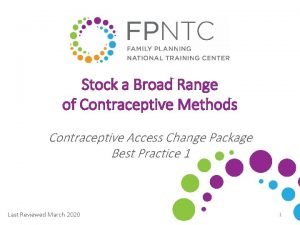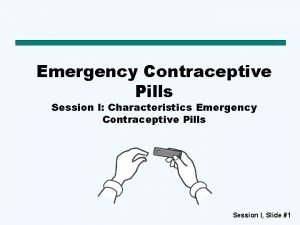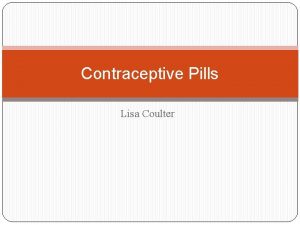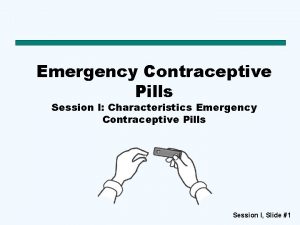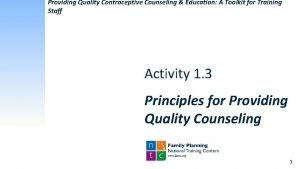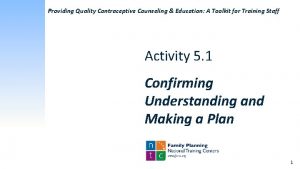Improving Contraceptive Counseling through Shared DecisionMaking Christine Dehlendorf




























































- Slides: 60

Improving Contraceptive Counseling through Shared Decision-Making Christine Dehlendorf, MD MAS Biftu Mengesha, MD Angeline Ti, MD MPH

Structure of Course • Part 1: Overview of shared decision making • Part 2: Role-playing • Part 3: Case-based exercises

Part 1

Outline • Why does health communication matter? • Contraceptive counseling – Different counseling approaches – Role of SDM – How do you implement SDM into practice?

Importance of Health Communication

Health Communication: Why does it matter? • Influences the formation of a positive therapeutic relationship between the provider and the patient • Is essential to providing information about diagnoses and treatment plans • Positive association between patient experience of interpersonal communication and both subjective and objective health outcomes

What evidence is there the value of contraceptive counseling? • Counseling influences method selection • Quality of family planning care associated with use of contraception and satisfaction with method • And…. patient-centeredness is the right thing to do Dehlendorf, unpublished data Rosenberg, Fam Plann Perspect, 1998 Forrest, Fam Plann Perspect, 1996 Harper, Patient Ed Counsel, 2010

Contraceptive Counseling

What are the stages of counseling? • Identifying need for contraception • Counseling about method options and selecting a method (i. e. contraceptive decision making) • Providing information about chosen method

Approaches to Contraceptive Decision Making Consumerist Counseling Directive Counseling

Consumerist Counseling • Informed Choice – Provides only objective information and does not participate in method/treatment selection itself • Foreclosed: – Only information on methods asked about by the patient are discussed • Both prioritize autonomy

Consumerist Counseling Most Common • Observational study of contraceptive counseling – 80% of visits used “foreclosed” or “informed choice” approach • Patient preferences elicited in less than 50% of visits • Providers infrequently mention or elicit women’s reproductive goals Dehlendorf, Contraception, 2015 and unpublished data

Problems with Consumerist Counseling • Foreclosed: Fails to ensure women are aware of and have accurate information about methods • Informed Choice: Provider does not assist patient in understanding how preferences relate to method characteristics or tailor information to patients needs

Approaches to Contraceptive Decision Making Consumerist Counseling Directive Counseling

Directive Counseling • Provides information and counseling designed to promote use of specific methods • Paternalistic method of communication • Rooted in the healthcare provider’s preferences, or assumptions about the patient’s priorities

Directive Counseling Towards LARC Methods • Examples of directive counseling towards LARC: – Tiered effectiveness – Motivational interviewing • No data supporting this approach • What should goal of counseling be? • Pressure to use methods may be counterproductive (Kalmuss, 1996)

Contraceptive Decision Making Consumerist Counseling Promote patient autonomy Directive Counseling Increase use of highly effective methods Shared Decision Making

Shared Decision Making “A collaborative process that allows patients and their providers to make health care decisions together, taking into account the best scientific evidence available, as well as the patient’s values and preferences…. This process provides patients with the support they need to make the best individualized care decisions. ” – Informed Medical Decisions Foundation

Shared Decision-Making in Family Planning • Choice of a contraceptive method is a preference-sensitive decision – Best method for an individual depends on her preferences • Women will weight effectiveness differently relative to other characteristics • Consistent with women’s preferences for counseling – Active facilitation, without expressing a preference, may be optimal

Shared Decision Making in Family Planning “I just think providers should be very informative about it and nonbiased…maybe not try to persuade them to go one way or the other, but maybe try to find out about their background a little bit and what their relationships are like and maybe suggest what might work best for them but ultimately leave the decision up to the patient. ” Dehlendorf, Contraception, 2013 20

Contraceptive Counseling and Disparities • Women have color have higher rates of unintended pregnancy – Has the potential to encourage directive counseling • Especially concerning given historical context – 35% of Black women reported “medical and public health institutions use poor and minority people as guinea pigs to try out new birth control methods. ” Thorbun and Bogart, Women’s Health, 2005

Are women of color counseled differently? • Phone survey of 1, 800 women – Minorities and women with lower education levels are more likely to be report being dissatisfied with their family planning provider • Survey of 500 Black women – 67% reported race based discrimination when receiving family planning care Forrest and Frost, Fam Plann Perspect 1996 Thorbun and Bogart, Women’s Health, 2005

Are women of color counseled differently? • Minority and low-income women are more likely to report being pressured to use a birth control method and limit their family size • Providers are more likely to agree to sterilize minority and poor women • Providers more likely to recommend IUDs to low. SES black and Latina women than to low–SES white women Downing et al, AJPH, 2007 Harrison, Obstet Gynecol 1988 Dehlendorf, AJOG, 2010

Counseling and Family Planning Disparities • Given historical context and documented disparities in counseling, essential to ensure that providers focus on individual preferences when caring for women of color • Shared decision making provides explicit framework for doing this, without swinging too far to other side

How can contraceptive decision making be optimized?

The Process of Shared Decision Making • Establish rapport • Focus on patient preferences: – “What is important to you about your method? ” – Probes: • • • Effectiveness Frequency of using method Different ways of taking methods Return to fertility (Specific) side effects

Talking About Effectiveness • Effectiveness often very important to women • Frequent misinformation or misconceptions about relative effectiveness of methods • Effectiveness rarely mentioned – Only 21% of all visits in which IUDs mentioned • Use natural frequencies: – Less than 1 in 100 women get pregnant on IUD – 9 in 100 women get pregnant on pill/patch/ring • Use visual aids

Don’t Assume Women Know Their Options • Provide context for different method characteristics – e. g. “There are methods you take once a day, once a week, once a month, or even less frequently. Is that something that makes a big difference to you? ” • Even if express strong interest in one method, ask for permission to provide information about other methods

OCP Effectiveness

IUD Effectiveness

Sharing Decision Making • Provide scaffolding for decision making – Given their preferences, what information do they need? – Actively facilitate, while avoiding stating opinions not based on patient preferences

Examples of Facilitation • “I am hearing you say that avoiding pregnancy is the most important thing to you right now. In that case, you may want to consider either an IUD or implant. Can I tell you more about those methods? ” • “You mentioned that it is really important to you to not have irregular bleeding. The pill, patch, ring and copper IUD are good options, if you want to hear more about those. ”

Provide Adequate Information about Side Effects • Studies have found that many women report that they: – Do not receive adequate information – Feel providers dismiss concerns and overlook possible side effects • Counseling about side effects associated with positive outcomes Canto De Centina, Contraception, 2001 Becker, Perspect Sex Repro Health, 2007 Dehlendorf, Contraception, 2013 Yee, JHCPU, 2011

Experiences of Contraceptive Counseling “I think that they hide the fact of the complications or the defects, the things that might happen if you take that. They don’t give you that information and I don’t think any provider has given me that information. ” Dehlendorf, Contraception, 2013

Address Patient’s Concerns – Know the evidence about which side effects have in fact are proven to be associated with methods – Proactively address patient concerns about other side effects in a respectful manner “That’s too bad your friend had that experience. I haven’t heard of that before, and I can tell you it definitely doesn’t happen frequently. My guess is that if you were to use this method it would not happen to you. ”

Once a Method is Chosen…. • Provide opportunity to ask questions – Done in less than 50% of all counseling visits • Discuss what to do if not satisfied with method (contingency counseling) – Only done in 65% of visits • Facilitate actually receiving chosen method • Ensure that discontinuation is discussed when implant or IUC chosen Dehlendorf, unpublished data Namerow, Fam Plann Perspect, 1989

Shared Decision Making • Establish rapport • Elicit patient preferences with direct questioning – Provide context about options • Provide scaffolding for decision making process – Include adequate information about side effects, effectiveness and logistics of method use • Ensure access to chosen method and discuss discontinuation

Questions?

Part 2

Role-Playing • 2 volunteers: 1 student will be the healthcare provider, and 1 student will be the patient. • The patient is a woman presenting to the clinic seeking to discuss and initiate contraception. She has not used contraception before. • Using the information presented about shared decision-making, act out a healthcare encounter in which the healthcare provider applies the shared decision-making model to this contraceptive counseling visit.

Review Role Playing Experience – What aspects of this exercise were challenging or frustrating? – Did it go as you expected? – What did you like about it? – How was it different or similar to patient encounters you’ve had previously?

My Birth Control • i. Pad tool designed to facilitate shared decision making • Provides women with information about their options, focusing on: – Effectiveness – How methods are taken – How often methods are taken – Side effects and benefits – Return to fertility

My Birth Control • Preference elicitation exercise • Identification of methods that are consistent with preferences across different dimensions • Opportunity to ask questions and indicate which methods wish to discuss with provider • Printout of preferences, contraindications, questions, methods of interest

My Birth Control • Can use printout to make counseling more efficient – Know patients have had opportunity to be informed about options – Have information about preferences and places they may be discordant – Can dive into iterative process of considering options

Part 3

Case-based Learning

Case 1 • A 21 yo G 0 P 0 presents to the family planning clinic requesting Depo-Provera for contraception. She has never used contraception before, but is considering becoming sexually active soon and wishes to initiate a new contraceptive method. Her friends use “the shot” and she thinks she would like this method. How would you counsel this patient?

Case 1: Learning Points • Should always start by acknowledging patient preferences • Elicit rationale for preference in order to: – Evaluate whether it is an informed choice by assessing patient’s preferences – Identify other possible appropriate methods • Ask the patient for permission to discuss other methods of contraception that align with stated preferences

Case 2 • An adolescent presents to the office for an annual well-visit. She is sexually active and currently uses condoms and withdrawal for contraception. She is satisfied with this method of contraception. How would you counsel this patient?

Case 2: Learning Points • Establishing rapport is the most important first step! • More tendency to be directive with adolescents – Need to prioritize autonomy – Providers being directive can elicit reaction in this age group • Can choice of condoms and withdrawal represent an informed choice?

Case 2: Learning Points • Elicit the patients preferences surrounding method characteristics, including effectiveness – Evaluate if her contraceptive choice aligns with her stated goals – Provide education about relative effectiveness of methods as appropriate • Promote continued use of condoms to prevent STI transmission • Screen for reproductive coercion and/or abuse

Case 3 • A 25 yo G 0 woman presents to discuss switching her contraceptive method from OCPs to an IUD. She has used OCPs for the past 10 years without any problems. She asks if you have an IUD or if you would switch to an IUD if you were her. How would you respond?

Case 3: Learning Points • Self-disclosure is controversial in the general medical literature – Balance between relationship building and inappropriate influence • In family planning, limited evidence it can be acceptable – Consistent with desire for intimate relationship with provider – May be most appropriate after method selection • Decision to disclose should be individualized • Disclosure should be followed by reestablishing focus on patient’s needs and preferences

Case 4 • A 19 yo G 2 P 2 presents to the clinic 5 months after she had an IUD inserted, requesting you remove it. She had thought she was done having children but began a new relationship 1 month ago and now is unsure if she wants to have more kids, but “wants to still have that option. ” How would you counsel this patient?

Case 4: Learning Points • Tendency for high efficacy of IUD to motivate providers to promote continuation of this method • Begin with assurance that will remove method at patient request • SDM refocuses attention on woman’s preferences – Side effects with method? – Fear about future fertility? – Desire for or ambivalence about pregnancy? • Ensure patient preferences are well-informed and supported

Case 5 • A 23 yo presents to the family planning clinic after an abortion. This was her 6 th abortion. During the counseling session, when you ask her if she would like to discuss birth control at this visit she replies, “No” and makes it clear she does not wish to discuss this further. How would you proceed with this counseling session?

Case 5: Learning Points • May have a desire to encourage contraceptive use in this high risk patient • However, this can conflict with a focus on providing the care that is consistent with her preferences • Continuity relationship with patient may be best means of helping her meet her family planning needs • Recognize that patients may prefer to risk pregnancy rather than use a method that is not acceptable to them • SDM provides structure to ensure patient has verbalized her preferences and has the information and support to make decisions consistent with these preferences

Review: 5 Steps to Improving Contraceptive Counseling through SDM 1) Establish rapport, build trust 2) Elicit and clarify patients’ priorities, values, preferences, and personal situation 3) Provide evidence-based information including risks, benefits, and side effects for contraceptive methods that best align with patients’ stated preferences • May use decision aids to facilitate patient education

Review: 5 Steps to Improving Contraceptive Counseling through SDM 4) Encourage and enable the patient to ask questions 5) Facilitate the selection of a mutually agreeable contraceptive choice that reflects that patients preferences and satisfies the patient

Questions?
 Survey of household economics and decisionmaking
Survey of household economics and decisionmaking Celine contraceptive pill
Celine contraceptive pill Contraceptive
Contraceptive Contraceptive
Contraceptive Mode d'action de la pilule contraceptive
Mode d'action de la pilule contraceptive Neten contraceptive
Neten contraceptive Mama methode contraceptive
Mama methode contraceptive Night of the scorpion talks about
Night of the scorpion talks about Through one man sin entered the world, and through one man
Through one man sin entered the world, and through one man Furcation involvement classification
Furcation involvement classification Tangential sawing advantages
Tangential sawing advantages Collins title productivity
Collins title productivity Improving software economics set 1
Improving software economics set 1 Contract synoynm
Contract synoynm Nist framework for improving critical infrastructure
Nist framework for improving critical infrastructure Cas jasig
Cas jasig Improving vocabulary skills chapter 9
Improving vocabulary skills chapter 9 Behavioral assessment scale for intercultural competence
Behavioral assessment scale for intercultural competence Improving own learning and performance examples
Improving own learning and performance examples Improving operational performance
Improving operational performance Condone noun form
Condone noun form Improving vocabulary with word parts and context clues
Improving vocabulary with word parts and context clues What is the use of pi
What is the use of pi Improving vocabulary skills 4th edition
Improving vocabulary skills 4th edition Improving process capability means;
Improving process capability means; Duane feels he too many years
Duane feels he too many years Service quality and productivity
Service quality and productivity Chapter 12 • lesson 1 benefits of physical activity
Chapter 12 • lesson 1 benefits of physical activity Nist cybersecurity framework roadmap
Nist cybersecurity framework roadmap Improving student learning one teacher at a time
Improving student learning one teacher at a time Ten steps to advancing college reading skills answers
Ten steps to advancing college reading skills answers Improving the reliability of commodity operating systems
Improving the reliability of commodity operating systems The service performance gap
The service performance gap Improving software economics set 1
Improving software economics set 1 Improving chronic illness care model
Improving chronic illness care model Improving vocabulary with word parts and context clues
Improving vocabulary with word parts and context clues Transforming hr service delivery at kellogg
Transforming hr service delivery at kellogg A practical guide for improving flight path monitoring
A practical guide for improving flight path monitoring A sense of belonging improving student retention
A sense of belonging improving student retention Thoughtworks code witch
Thoughtworks code witch A linear-time heuristic for improving network partitions
A linear-time heuristic for improving network partitions Improving decision making and managing knowledge
Improving decision making and managing knowledge Decreasing turnover time operating room
Decreasing turnover time operating room Gaps model for improving service quality
Gaps model for improving service quality Improving patient registration process
Improving patient registration process Improving the patient journey
Improving the patient journey Ten steps to improving college reading skills
Ten steps to improving college reading skills Glencoe health chapter 12
Glencoe health chapter 12 Improving critical infrastructure cybersecurity
Improving critical infrastructure cybersecurity Improving security performance
Improving security performance Strategies for improving intercultural communication
Strategies for improving intercultural communication What is hill's prescription for improving one's vocabulary
What is hill's prescription for improving one's vocabulary Using assessment data for improving teaching practice
Using assessment data for improving teaching practice Benefits and difficulties of improving quality
Benefits and difficulties of improving quality Boring sentences to improve
Boring sentences to improve Ahrq safety program for improving antibiotic use
Ahrq safety program for improving antibiotic use Improving search relevance
Improving search relevance Nurses improving care for healthsystem elders
Nurses improving care for healthsystem elders Improving student learning one teacher at a time
Improving student learning one teacher at a time Christine marleau
Christine marleau Dennis kostka
Dennis kostka

